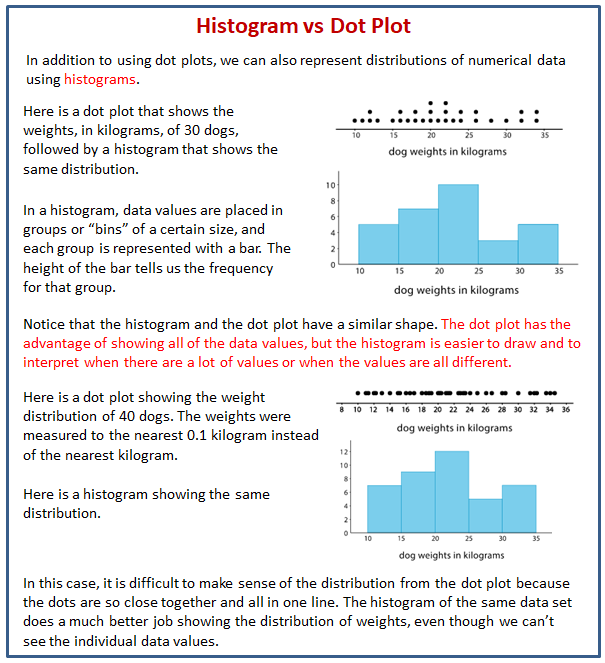Illustrative Mathematics Unit 6.8, Lesson 6: Histograms
Learning Targets:
- I can recognize when a histogram is an appropriate graphical display of a data set.
- I can use a histogram to get information about the distribution of data and explain what it means in a real-world situation.
Related Pages
Illustrative Math
Grade 6
Lesson 6: Histograms
Let’s explore how histograms represent data sets.
Illustrative Math Unit 6.8, Lesson 6 (printable worksheets)
Lesson 6 Summary
The following diagram shows how to use histograms and dot plots to represent data sets.

Lesson 6.1 Dog Show (Part 1)
Here is a dot plot showing the weights, in pounds, of 40 dogs at a dog show.
- Write two statistical questions that can be answered using the dot plot.
- What would you consider a typical weight for a dog at this dog show? Explain your reasoning.
Lesson 6.2 Dog Show (Part 2)
Here is a histogram that shows some dog weights in pounds.
Each bar includes the left-end value but not the right-end value. For example, the first bar includes dogs that weigh 60 pounds and 68 pounds but not 80 pounds.
- Use the histogram to answer the following questions.
a. How many dogs weigh at least 100 pounds?
b. How many dogs weigh exactly 70 pounds?
c. How many dogs weigh at least 120 and less than 160 pounds?
d. How much does the heaviest dog at the show weigh?
e. What would you consider a typical weight for a dog at this dog show? Explain your reasoning. - Discuss with a partner:
- If you used the dot plot to answer the same five questions you just answered, how would your answers be different?
- How are the histogram and the dot plot alike? How are they different?
Lesson 6.3 Population of States
Every ten years, the United States conducts a census, which is an effort to count the entire population. The dot plot shows the population data from the 2010 census for each of the fifty states and the District of Columbia (DC).
- Here are some statistical questions about the population of the fifty states and DC. How difficult would it be to answer the questions using the dot plot?
In the middle column, rate each question with an E (easy to answer), H (hard to answer), or I (impossible to answer). Be prepared to explain your reasoning. - Here are the population data for all states and the District of Columbia from the 2010 census. Use the information to complete the table.
- Use the grid and the information in your table to create a histogram.
- Return to the statistical questions at the beginning of the activity. Which ones are now easier to answer?
In the last column of the table, rate each question with an E (easy), H (hard), and I (impossible) based on how difficult it is to answer. Be prepared to explain your reasoning.
Are you ready for more?
Think of two more statistical questions that can be answered using the data about populations of states. Then, decide whether each question can be answered using the dot plot, the histogram, or both.
Glossary Terms
histogram
A histogram is a way to represent data on a number line. Data values are grouped by ranges. The height of the bar shows how many data values are in that group.
Lesson 6 Practice Problems
- Match histograms A through E to dot plots 1 through 5 so that each match represents the same data set.
- Here is a histogram that summarizes the lengths, in feet, of a group of adult female sharks. Select all the statements that are true, according to the histogram.
A. A total of 9 sharks were measured.
B. A total of 50 sharks were measured.
C. The longest shark that was measured was 10 feet long.
D. Most of the sharks that were measured were over 16 feet long.
E. Two of the sharks that were measured were less than 14 feet long. - This table shows the times, in minutes, it took 40 sixth-grade students to run 1 mile.
- (-2,3) is one vertex of a square on a coordinate plane. Name three points that could be the other vertices.
The Open Up Resources math curriculum is free to download from the Open Up Resources website and is also available from Illustrative Mathematics.
Try out our new and fun Fraction Concoction Game.
Add and subtract fractions to make exciting fraction concoctions following a recipe. There are four levels of difficulty: Easy, medium, hard and insane. Practice the basics of fraction addition and subtraction or challenge yourself with the insane level.

We welcome your feedback, comments and questions about this site or page. Please submit your feedback or enquiries via our Feedback page.